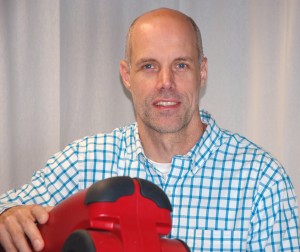It all started when teenager Mark Moll’s parents bought a computer. Looking back, the Computer Science senior research scientist said, “They had no CS background and I think they mainly got it for some basic word-processing. It came with a BASIC interpreter and through trial and error, I managed to write some simple programs.”
Moll’s growing interest in the combination of computer science and applied mathematics prompted his pursuit of a M.S. in CS degree from the University of Twente in the Netherlands, and a PhD from Carnegie Mellon.
He said, “In graduate school I studied how one could reconstruct the shape and motion of unknown objects sliding around a robot’s palms. If you close your eyes and someone hands you an unknown object, you still have a pretty good idea what this object looks like based on the information you get from the sense of touch. I formalized this notion and showed that under certain conditions you can exactly reconstruct shape and motion.”
Moll first arrived at Rice as a post-doc working in both Lydia Kavraki’s group and the Keck Center for Computational Biology. Then the Information Science Institute, part of the University of Southern California, hired him to help develop algorithms and software infrastructure for the SuperBot, a multifunctional and modular robot system.
Moll returned to Rice in 2007 to focus on tracing conformational changes in proteins in the Kavraki Lab. He also leads the development of the Open Motion Planning Library, an initiative “to provide the robotics community with efficient implementations of many state-of-the-art robot motion planning algorithms.”
“The initial development was started by one of our former graduate students…Ioan Şucan (now at Google X). The development of this library coincided with the development of the Robot Operating System (ROS), a widely-used software framework that runs on many robots. OMPL is used within ROS, which means you can use it directly with a large number of robots. However, OMPL can also be used without it…over time many other robotics software frameworks have added support for it,” said Moll.
Moll joined the project in 2010 and collaborated with Şucan to refine the library into clear core concepts of robot motion planning. The library software has since matured, receiving contributions from many students in and out of Rice, as well as researchers around the world. Meanwhile, Moll’s team has actively fostered a user community via conferences and tutorials whose teaching material is based on OMPL software and online activities that make it easy to get started and later contribute.
“I have been very lucky to have worked with some very talented undergraduates on OMPL-related projects,” Moll said. “Caleb Voss (class of 2016, now a graduate student at Georgia Tech) published a paper about his work at one of the top robotics conferences. Prudhvi Boyapalli (class of 2017) has developed a really cool web-based graphical front-end for OMPL, which allows users to experiment with different algorithms without having to write a line of code.”
When asked what drew him back to Rice, Moll said, “I like the friendly atmosphere within the [CS] department. Even though the department has grown over the years, it is still very much a community.”
Mark Moll joined the research staff in the CS department in 2002.
–Juliann Bi, Computer Science Marketing Assistant
